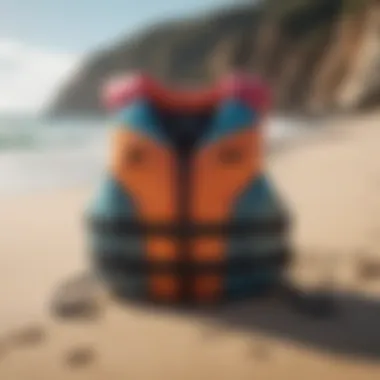Understanding Surf Float Vests: A Comprehensive Guide


Intro
Surf float vests are essential safety gear for both kitesurfers and kiteboarders. They provide buoyancy and support in challenging water conditions. Understanding their design, purpose, and features helps riders make informed decisions. This section will cover how to select the best float vest, its importance in ensuring safety, and its influence on performance.
The Importance of Float Vests
Float vests serve multiple purposes. First, they enhance safety. Riding in open water presents inherent risks. Waves, currents, and strong winds can lead to unexpected situations. Wearing a float vest helps buoy the rider, allowing for easier recovery. This benefit is critical during falls or equipment failures.
Float vests also contribute to comfort. Many designs focus on a snug fit that allows for full mobility while riding. Riders can maneuver without restraint, which is necessary for effective performance.
Key Features of Good Float Vests
When selecting a float vest, several key characteristics to consider:
- Buoyancy: The primary function of a float vest is keeping the rider afloat. Look for vests with well-distributed buoyancy.
- Fit and Comfort: A good fit is vital. A vest that is too loose may not provide the needed support. One that is too tight can restrict movement.
- Material: Many vests are made from neoprene or similar materials. These materials offer flexibility and durability.
- Safety Design: Look for vests that have reflective panels for visibility. These features are important for safety, especially in crowded or low-light conditions.
Choosing the Right Vest
Each rider has unique needs. Newer riders may prioritize buoyancy and stability, while more experienced surfers might seek flexibility for tricks and maneuvers. Evaluating personal requirements is crucial to making the best choice.
Here are some tips for choosing the right vest:
- Assess Activity Level: Consider whether you are a beginner or an advanced rider.
- Test for Fit: Always try on a vest before purchasing. A snug fit is essential.
- Check Regulations: Some areas have specific safety gear requirements. Ensure compliance with local rules.
In summary, understanding the function of surf float vests aids riders in making educated decisions. These garments are not only functional; they can positively affect performance and comfort while riding.
Foreword to Surf Float Vests
Surf float vests play a vital role in kitesurfing and kiteboarding. This specialized gear not only aids in buoyancy but also contributes significantly to the overall safety and performance of the rider. In this section, we will explore the essential attributes of surf float vests, their purpose, and the historical context that has led to their development. Understanding these elements is crucial for both newcomers and experienced athletes, as it lays the foundation for safe and effective water practices.
Definition and Purpose
A surf float vest is a type of personal flotation device designed specifically for water sports such as kitesurfing and kiteboarding. Its primary aim is to enhance safety by providing buoyancy in case of falls into the water. Unlike traditional life jackets, which are bulkier and can hinder movement, surf float vests are streamlined. They allow athletes to maintain their agility while ensuring adequate floatation. Furthermore, these vests often incorporate additional features such as impact protection and pockets for storage, catering to the unique needs of extreme athletes.
Historical Background
The evolution of surf float vests aligns with the growing popularity of water sports. Initially, flotation devices were simple and cumbersome, offering minimal comfort or style. As kitesurfing and kiteboarding gained traction in the late 20th century, the need for more specialized gear became evident. Manufacturers began to design vests that would not only provide buoyancy but also optimize performance.
Advances in materials technology led to the development of neoprene and lightweight foam, allowing for more comfortable and efficient designs. The modern surf float vest has become an essential piece of safety equipment, meant to protect riders without compromising their ability to maneuver effectively on the water.
Understanding the evolution of surf float vests helps riders appreciate the importance of selecting the right vest for their activities and safety requirements.
Design Characteristics of Surf Float Vests
Understanding the design characteristics of surf float vests is essential for ensuring optimal performance and safety. These vests provide flotation, impact resistance, and comfort, which are vital for kitesurfers and kiteboarders. The materials used, types available, and fit considerations all play a significant role in how well a vest performs in various surf conditions. While aesthetics can be appealing, the primary focus should always be on functionality and safety features.
Materials Used
Neoprene
Neoprene is a popular material used in surf float vests. Its key characteristic is its flexibility and thermal insulation properties. This makes it suitable for use in cold water conditions. Neoprene keeps the body warm, which is beneficial for prolonged exposure to chilly water. One unique feature of neoprene is its ability to stretch without losing shape, enhancing comfort during movement.
However, neoprene vests can sometimes retain water, which adds weight when wet. Users may find that after a fall, the vest becomes heavier, which is a consideration to keep in mind.
Foam Inserts
Foam inserts are integral to many surf float vests, primarily for their buoyancy. The primary aspect of foam inserts is that they offer a significant flotation advantage in water. This characteristic can be life-saving, especially in rough conditions. Foam is also lightweight and does not require inflation, making it easy to wear at all times.
One unique feature of foam inserts is that they maintain their buoyancy even when wet, providing reliable performance over time. On the downside, foam vests may not provide the same level of comfort as neoprene in colder waters compared to thicker neoprene vests.
Durability
Durability is another crucial aspect of surf float vests. The key characteristic of durable vests is their ability to withstand harsh marine environments, including saltwater and UV exposure. Durability ensures that a vest can last for multiple seasons without significant wear and tear.
One unique feature of highly durable vests is reinforced stitching and materials that resist punctures. This can prevent costly replacements. However, vests that are built for durability tend to be heavier, which can affect agility during use.


Types of Vests
Inflatable vests
Inflatable vests are designed for performance. They can be compact and lightweight, making them a popular choice for extreme athletes looking for maximum mobility. The key characteristic of inflatable vests is that they provide adjustable buoyancy as they can be inflated or deflated as needed.
A unique feature of these vests is their ability to pack down to a smaller size, allowing easy storage when not in use. However, reliance on inflation means that users must ensure their vests are functioning correctly before heading into the water, which can lead to safety concerns if overlooked.
Non-inflatable vests
Non-inflatable vests are often made of solid materials like neoprene or foam. They are typically more reliable since they don’t require any inflation mechanisms. The key characteristic is consistent buoyancy and performance in the water at all times without the need for maintenance.
One unique feature of non-inflatable vests is the level of comfort and warmth they can provide, as many are designed with additional thermal properties. However, these vests can be bulkier compared to inflatable options, limiting flexibility in some extreme conditions.
Fit and Comfort
Sizing considerations
Choosing the correct size is critical for surf float vests. The key characteristic of proper sizing is that a well-fitted vest helps prevent water from entering, which enhances overall buoyancy and comfort. A vest that is too loose may not provide adequate protection, while one that is too tight can restrict movement and circulation.
A unique feature in sizing is the range of adjustments available through various brands, which can help cater to different body types. However, it is essential to try on vests before purchase as sizing can vary significantly between brands.
Adjustable features
Enhancements in adjustable features are a significant development in surf float vests. The key characteristic here is the inclusion of adjustable straps and buckles that allow for a customizable fit. This is particularly beneficial in maintaining comfort during extended wear.
A unique feature of adjustable vests is the ability to adapt to changes in body size or gear layering, making them versatile options. On the downside, some users may find the added components cumbersome or prone to failure, which can affect safety.
Safety Features of Surf Float Vests
Safety is paramount when it comes to engaging in water sports, especially for kitesurfers and kiteboarders. Surf float vests are designed not just for comfort and mobility, but their safety features play a critical role in ensuring the well-being of riders. Understanding these aspects can significantly impact choices made when selecting the appropriate vest.
Buoyancy Ratings
The buoyancy rating of a surf float vest denotes its ability to keep a user afloat in water. This rating is influenced by several factors including the materials used and the amount of flotation material integrated into the vest. Typically, buoyancy is expressed in Newtons (N) or pounds (lbs), with the general recommendation being a minimum buoyancy of 50N for water sports.
A higher buoyancy rating means that the vest can support larger individuals or provide additional security in rough water conditions. It is essential for users to consider their body weight and skill level when choosing a vest with the appropriate buoyancy rating. Beginners may benefit from a vest that offers more buoyancy, whereas experienced riders may prefer a lighter vest that allows for greater mobility.
"Selecting the right buoyancy level is not just about personal comfort; it can also dictate how effectively a rider can handle unexpected situations on the water."
Impact Resistance
Impact resistance is another crucial safety feature in surf float vests. This term refers to the vest's ability to absorb shocks and reduce potential injuries during falls or collisions. Vests designed specifically for high-impact activities like kitesurfing often incorporate materials that are more resilient, providing better protection.
The materials used for impact resistance vary. Some vests might integrate closed-cell foam that remains buoyant even when submerged. This foam can effectively lessen the impact from falls onto harder surfaces like water during high-speed maneuvers.
When evaluating impact resistance, it is important to consider both the nature of the sport and the individual's skill level. More advanced riders may engage in riskier maneuvers, making a vest with superior impact resistance essential. In contrast, casual riders might prioritize comfort over additional protection.
In summary, the safety features of surf float vests, particularly buoyancy ratings and impact resistance, are invaluable in ensuring a safe and enjoyable riding experience. Understanding these features allows users to select a vest that aligns with their specific needs and skill levels.
Performance Benefits
The performance benefits of surf float vests are multifaceted. They extend beyond mere flotation, influencing how kitesurfers and kiteboarders interact with the water. This section will clarify how these vests enhance rider capability and overall enjoyment while engaging in water sports.
Impact on Mobility
Mobility can be a critical factor for those navigating the dynamics of kitesurfing. Wearing a surf float vest should not hinder agility. Modern designs integrate light yet durable materials like neoprene, which provide necessary buoyancy without excessive bulk. This design allows for a full range of motion, enabling riders to execute maneuvers and turns effectively.
Riders can experience significant benefits when their vests allow freedom in movement. The right vest will accommodate various styles, whether focusing on speed or tricks. Therefore, choosing a vest that fits snugly yet comfortably is essential. Some options allow for adjustments at the sides or shoulders.
These features help maintain a balance between safety and performance. The right vest can enhance confidence during stunts or high-speed runs. Riders often report feeling less restricted, which can lead to greater overall satisfaction.
Enhancement of Hydrodynamics
Hydrodynamics plays a pivotal role in water sports. A well-designed surf float vest should improve how riders cut through water. Vests that aim for streamlined shapes can minimize drag, helping to maintain speed during rides.
Improved hydrodynamics are not just about speed but also stability. Vests made with thoughtful design can help distribute buoyancy evenly. This balance contributes to maintaining an upright position in the water, which in turn optimizes energy efficiency. If a vest creates turbulence or drag, it can lead to fatigue more quickly.


Furthermore, vests that fit well discourage excessive water movement between the vest and the body, resulting in a smoother experience overall. Riders can glide with less resistance, making each ride feel more effortless. In summary, the choice of vest can significantly impact both performance and enjoyment in the water.
Selecting the Right Surf Float Vest
Selecting the correct surf float vest is crucial for both safety and performance on the water. It is vital to align the vest's features with personal needs and riding style. The following sections will delve into individual requirements and key characteristics that every rider should consider.
Assessing Personal Needs
Skill Level
Skill level plays an integral role in selecting a surf float vest. Beginners may need a vest that provides more buoyancy and support. This allows them to build confidence while learning essential skills. Experienced riders might prefer a slimmer, less restrictive design for better mobility. The choice of vest reflects one's comfort and confidence in the water.
The key characteristic of skill level is its direct influence on safety decisions. A vest suited for a novice can feature more flotation, whereas an advanced user may need less buoyancy to avoid feeling encumbered. Considerations should include how the vest enhances or hinders movement and overall comfort while kitesurfing.
Advantages of selecting based on skill level include tailored safety and maximizing performance. However, a misunderstanding of one’s ability may lead to inappropriate choices, which can affect overall enjoyment and safety.
Type of Water Conditions
Understanding the water conditions where you plan to ride is equally important. Different conditions require different vest characteristics. For example, riding in calm waters often allows for more flexibility in vest design. Conversely, extreme conditions demand enhanced safety features, like high buoyancy and rugged construction.
The key characteristic of type of water conditions is its ability to determine how well a vest will perform. Vests designed for choppy or turbulent water might offer reinforced straps and increased flotation capacity.
A unique feature of this consideration is the specific design adjustments meant for safety, such as reinforced seams for durability. For surfers operating in unpredictable conditions, this can prevent potential injuries. Understanding the environment can enhance safety, but inappropriate selection might expose a user to hazards.
Key Features to Consider
Closure type
The closure type is significant in ensuring a snug fit and comfort. Options such as zipper closures, Velcro straps, or snap buttons all present unique advantages. Zipper closures tend to offer a secure fit, minimizing accidental openings during use. Meanwhile, Velcro straps provide easy adjustments on the go, which is useful for those constantly changing their gear.
The key characteristic of the closure type is how it influences safety and convenience. A secure closure maintains the vest's position during intense activity, while a poorly designed one could risk slippage.
Advantages include ease of use and security, while disadvantages might arise if the closure fails or is hard to manipulate with wet or gloved hands.
Pocket features
Pocket features in surf float vests are essential for carrying small items securely. Some vests include pockets specifically designed for storage convenience. These pockets might hold valuables like keys, tools, or snacks, enhancing the overall riding experience.
The key characteristic of pocket features is their utility in keeping essential items accessible and secure. A well-designed pocket can be waterproof, which adds substantial benefit for riders in wet environments.
Unique considerations include the practicality of pockets, as poorly placed or designed pockets can hinder performance. When designed well, they add convenience; however, features that increase bulk can impact agility during maneuvers.
Brand Comparisons
Brand comparisons offer valuable insights into the suitability of various surf float vest designs. Different brands prioritize different features, allowing surfers to make informed choices. Research into various offerings can highlight key differentiators in quality, innovation, and price. This section will delve into popular brands and what they provide, considering aspects such as craftsmanship and user reviews.
Common Misconceptions
When discussing surf float vests, it is crucial to address the common misconceptions that may mislead potential users. These misunderstandings can greatly influence decisions on safety and performance in water sports, particularly for kitesurfing and kiteboarding enthusiasts. Misconceptions can result in improper usage or even discourage some from utilizing these vital safety tools. Understanding these myths is essential for informed choices and maximum safety.
Float Vests vs. Life Jackets
A frequent misconception is that surf float vests and life jackets serve the same purpose. While they both offer buoyancy, their primary functions and designs differ significantly. Float vests are primarily designed for active water sports. They provide buoyancy while allowing enhanced mobility and freedom of movement. This is particularly important when executing maneuvers or when engaging in high-speed activities.
In contrast, life jackets are more about providing flotation in emergency situations. They are designed to turn an unconscious person face-up in the water, which is not the case with surf float vests. Float vests do not have the same level of inherent buoyancy required for this safety feature. Instead, they are tailored for performance during activities like kitesurfing, where a balance of buoyancy and flexibility is key.
Weight Considerations
Another misconception relates to the weight of surf float vests. Many believe that a heavier vest translates to better performance in terms of buoyancy. However, this is not always true. The materials used in constructing these vests can vary widely in weight and effectiveness.
While it is essential for surf float vests to have enough buoyancy to aid in flotation, excess weight can negatively impact mobility. A vest that is too heavy can hinder movements, making it difficult to perform efficiently in the water.
It is vital to choose a vest that balances buoyancy and weight. Lighter materials such as neoprene provide sufficient flotation without compromising agility.
Maintenance and Care


Proper maintenance and care of surf float vests is crucial for ensuring their longevity and reliability. Well-maintained vests not only perform better but also enhance safety for users. In the context of kitesurfing and kiteboarding, where water conditions can be unpredictable, the state of one's gear can significantly influence both performance and safety. Regular cleaning, proper storage, and attention to wear and tear are important elements that every rider should consider.
Cleaning Tips
To maintain the quality of surf float vests, one must prioritize regular cleaning. Saltwater, sand, and sun exposure can degrade materials over time, affecting buoyancy and performance. Here are some specific cleaning tips:
- Rinse Immediately: After each session, rinse the vest with fresh water to remove salt and sand. This step greatly reduces the risk of damage to the fabric and any internal foam.
- Use Mild Soap: For deeper cleaning, use a mild soap that won’t harm the vest's material. Scrub gently with a soft cloth or sponge to eliminate stubborn stains.
- Avoid Harsh Chemicals: Stay away from bleach or harsh solvents. Such substances can weaken the vest and compromise its buoyancy.
- Dry Properly: Hang the vest to dry in a shaded area. Direct sunlight can break down material integrity. Ensure it's fully dry before storage to prevent mildew.
Storage Recommendations
Proper storage is equally important as cleaning. How you store your surf float vest can affect its overall lifespan and performance. Here are some recommendations for effective storage:
- Cool, Dry Place: Store vests in a cool and dry area, free from moisture and excessive heat. This helps in maintaining the materials' resilience.
- Avoid Folding: Instead of folding, consider hanging the vest on a padded hanger. Folding can create creases that may weaken the fabric over time.
- Keep Away from Sharp Objects: Ensure the storage area is free from sharp objects that can cause punctures or abrasions to the vest. A dedicated storage bag can help protect it.
- Periodic Inspections: Regularly check the condition of your vest. Look for signs of wear or degradation and address any issues promptly to avoid further damage.
"The performance and safety of your surf float vest begin and end with how you care for it. Make maintenance a routine, and it will serve you well for years to come."
Overall, prioritizing maintenance and care will extend the life of surf float vests, ensuring that they remain reliable for all your kitesurfing adventures.
Regulatory Standards and Certifications
Regulatory standards and certifications play a crucial role in ensuring the safety and effectiveness of surf float vests. These guidelines are designed to protect users by establishing specific criteria that float vests must meet. Understanding these certifications enables kitesurfers and kiteboarders to make informed choices when purchasing their gear.
Understanding Safety Certifications
Safety certifications are assessments conducted by recognized entities to ensure that surf float vests adhere to defined standards. In many regions, these standards are influenced by organizations like the International Organization for Standardization (ISO) and various national maritime safety authorities. When a vest has the appropriate certifications, it signifies that it has been subjected to rigorous testing for buoyancy, impact resistance, and durability.
Many users may not realize that not all vests are equal. Some may look appealing but lack the necessary safety features. It is essential for riders to look for vests that display certificates indicating compliance with recognized safety standards. This not only assures quality but can also be critical in emergency situations.
Impact of Regulations on Design
Design elements of surf float vests are heavily influenced by regulatory requirements. Manufacturers must balance aesthetics with functionality to comply with these regulations. This can affect various aspects, from the materials used in construction to the overall buoyancy design.
For instance, vests that comply with EN ISO 12402 standards often incorporate high-performance materials that enhance durability and comfort. Regulations may dictate specific buoyancy levels, leading manufacturers to innovate in areas of weight distribution and airflow in the vests.
In summary, understanding regulatory standards and certifications is vital for anyone looking to purchase a surf float vest. It ensures not only safety but also informs design choices that influence performance and comfort during activities in the water. Always prioritize vests that meet and exceed these regulations for maximum safety and peace of mind while engaging in kitesurfing or kiteboarding.
The Role of Surf Float Vests in Environmental Safety
Surf float vests play a significant role in enhancing environmental safety, particularly for water sports enthusiasts such as kitesurfers and kiteboarders. These vests are not only designed for personal safety but also contribute to broader environmental responsibilities. By ensuring that users are better protected in aquatic settings, surf float vests indirectly promote a safer interaction with marine ecosystems.
The integration of eco-friendly materials in the production of surf float vests is a vital aspect. As awareness around sustainability grows, manufacturers are increasingly opting for materials that minimize environmental harm. These considerations help mitigate the ecological footprint associated with water sports gear. Using biodegradable or recyclable materials can reduce waste in oceans, thus supporting marine life.
Materials and Environmental Impact
When discussing the materials used in surf float vests, it is essential to highlight their selection based on environmental sustainability. Traditional materials such as neoprene, while effective for buoyancy, present challenges in terms of environmental impact due to their non-biodegradable nature. However, advancements in technology have led to the development of eco-friendly alternatives.
For instance, some brands have begun utilizing plant-based neoprene or recycled materials that offer comparable performance without the associated ecological damage. These innovative materials significantly lessen the negative interactions with the environment. They ensure the safety of the user while aligning with the pressing need to protect the oceans.
Additionally, maintaining the lifespan of surf float vests through proper care reduces the necessity for frequent replacements. This practice contributes to environmental safety by lowering waste and chemical use in manufacturing processes.
Promoting Safety Awareness
Promoting safety awareness through educational resources about surf float vests is critical. Awareness campaigns aimed at kitesurfers and kiteboarders can highlight not only the importance of wearing these vests but also the positive impact on environmental safety.
Engaging discussions in communities and forums, such as those on Reddit or Facebook, can spread important information about safe practices in water sports. Participants can share experiences, best practices, and recommendations for environmentally friendly products. Furthermore, organizations dedicated to ocean conservation can partner with brands to help promote this messaging in a more strategic manner.
"Environmental safety not only protects us but also the ecosystems we cherish. Wearing surf float vests is a crucial step in balancing safety and sustainability."
Lastly, integrating safety and environmental considerations into regulations and policies is imperative. By establishing guidelines that require the use of eco-friendly materials in surf float vests, regulatory bodies can safeguard marine environments while promoting athlete safety. This way, a culture of mindfulness can flourish among outdoor athletes, underscoring mutual respect for both personal safety and environmental preservation.
The End
In summary, understanding surf float vests is crucial for anyone who engages in kitesurfing or kiteboarding. These vests not only provide buoyancy and safety, but they also enhance performance and mobility. Choosing the right vest involves careful consideration of various factors such as personal needs, water conditions, and design characteristics. The safety features of surf float vests ensure that they meet the necessary standards for use in potentially hazardous environments.
Recap of Key Points
- Surf float vests are essential for buoyancy and safety in kitesurfing.
- The materials used in their design significantly affect comfort and durability.
- Proper fit and adjustable features are important for optimal performance.
- Safety certifications help to assure users about compliance with regulations.
- Maintenance practices extend the life of these vests and enhance performance.
Final Thoughts on the Importance of Surf Float Vests
As you dive into the thrilling world of kitesurfing and kiteboarding, having the right surf float vest is non-negotiable. It combines safety with performance enhancement, making it a key aspect of your gear. This simple yet essential piece of equipment can be the differentiator in both safety and enjoyment. Investing time into understanding what makes an effective surf float vest can lead to better choices and improved experiences on the water.
"The right equipment can not only improve your performance but also save your life."







